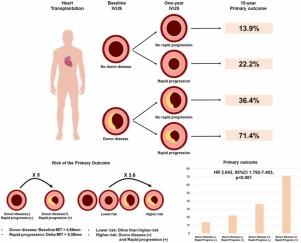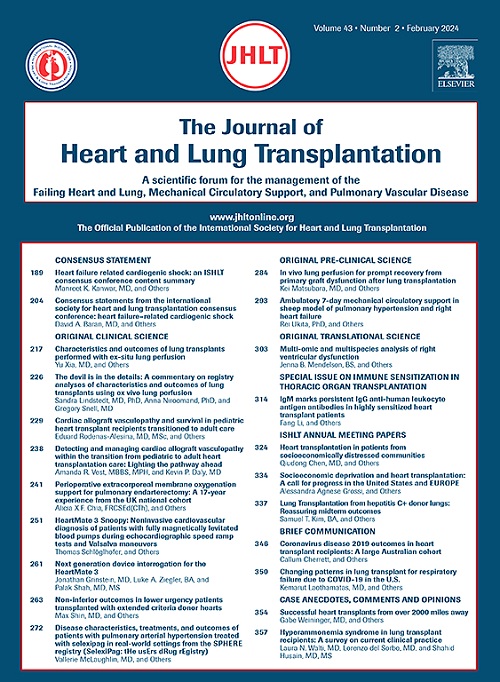Ten-year follow-up cohort of the everolimus versus azathioprine multinational prospective study focusing on intravascular ultrasound findings
IF 6.4
1区 医学
Q1 CARDIAC & CARDIOVASCULAR SYSTEMS
引用次数: 0
Abstract
Background
Long-term clinical outcomes of early intravascular ultrasound (IVUS) findings in a prospective cohort of heart transplantation (HTx) patients have not been evaluated.
Methods
This study included patients from 20 centers across Europe and North and South America among the original cohort of the RAD B253 study. Among these patients, 91 had paired IVUS images at baseline and 1-year post-transplant: everolimus 1.5 mg group (n = 25), everolimus 1.5 mg group (n = 33), and azathioprine 3.0 group (n = 33). The primary outcome was a composite of cardiovascular death, retransplantation, myocardial infarction (MI), coronary revascularization, and cardiac allograft vasculopathy (CAV) within a 10-year follow-up period. The secondary outcome was all-cause death, cardiovascular death, retransplantation, MI, coronary revascularization, and CAV. Donor disease was defined as baseline maximal intimal thickness (MIT) >0.66 mm, and rapid progression was defined as a change in MIT > 0.59 mm at 1 year.
Results
Donor disease (46 patients) was associated with a higher incidence of the primary outcome (hazard ratio (HR) 4.444, 95% confidence interval [CI] 1.946-10.146, p < 0.001). Rapid progression (44 patients) was associated with a significantly higher incidence of the primary outcome (HR 2.942, 95% CI 1.383-6.260, p = 0.005). Higher-risk features on IVUS (positive both donor disease and rapid progression) were independently associated with poor clinical outcomes (HR 4.800, 95% CI 1.816-12.684, p = 0.002).
Conclusions
An increase in baseline MIT and a change in first-year MIT in IVUS post HTx was associated with poor outcomes up to 10 years. Early IVUS findings can be considered as surrogate endpoints for evaluating long-term outcomes in HTx clinical trials.

埃维莫司与硫唑嘌呤多国前瞻性研究的十年随访队列,重点关注血管内超声检查结果。
背景:尚未对心脏移植(HTx)患者前瞻性队列中早期血管内超声(IVUS)发现的长期临床结果进行评估:本研究纳入了 RAD B253 研究原始队列中来自欧洲、北美和南美 20 个中心的患者。在这些患者中,91人在基线和移植后1年时有成对的IVUS图像,其中依维莫司1.5毫克组25人,依维莫司3.0毫克组33人,硫唑嘌呤组33人。主要结果是10年随访期内心血管死亡、再次移植、心肌梗死(MI)、冠状动脉血运重建和心脏异体移植血管病变(CAV)的综合结果。次要结果是全因死亡、心血管死亡、再次移植、心肌梗死、冠状动脉血运重建和CAV。供体疾病的定义是基线最大内膜厚度(MIT)大于0.66毫米,快速进展的定义是一年后MIT的变化大于0.59毫米:结果:供体疾病(46 例患者)与较高的主要结局发生率相关(HR 4.444,95% CI 1.946-10.146,p 结论:基线 MIT > 0.66 mm 的患者,其主要结局发生率较高:热灌注术后通过IVUS测量的基线MIT增加> 0.66 mm和第一年MIT变化> 0.59 mm与长达10年的不良预后有关。早期IVUS检查结果可作为替代终点,用于评估热灌注治疗临床试验的长期疗效。
本文章由计算机程序翻译,如有差异,请以英文原文为准。
求助全文
约1分钟内获得全文
求助全文
来源期刊
CiteScore
10.10
自引率
6.70%
发文量
1667
审稿时长
69 days
期刊介绍:
The Journal of Heart and Lung Transplantation, the official publication of the International Society for Heart and Lung Transplantation, brings readers essential scholarly and timely information in the field of cardio-pulmonary transplantation, mechanical and biological support of the failing heart, advanced lung disease (including pulmonary vascular disease) and cell replacement therapy. Importantly, the journal also serves as a medium of communication of pre-clinical sciences in all these rapidly expanding areas.

 求助内容:
求助内容: 应助结果提醒方式:
应助结果提醒方式:


